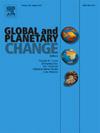The expansion of phytoplankton utilizing CO2 concentrating mechanisms during the late Cambrian SPICE event
IF 4
1区 地球科学
Q1 GEOGRAPHY, PHYSICAL
引用次数: 0
Abstract
The Steptoean positive carbon isotope excursion (SPICE) event represents one of the most pronounced perturbations of the global carbon cycle during the Early Paleozoic, postdating the end-Marjuman extinction. Profound oceanographic and biological changes occurred during the SPICE event, yet the underlying mechanisms driving this isotopic excursion and its precise linkages to concurrent environmental and biotic changes remain unresolved. This study presents high-resolution geochemical data from the Wangcun section in South China, revealing coupled positive δ13Ccarb and δ13Corg excursions and a negative δDorg shift. Multiple geochemical proxies confirm that these signatures preserve primary environmental signals rather than diagenetic artifacts. The SPICE event exhibits diachronous onset and variable magnitude across different depositional settings, challenging the notion of a globally synchronous anoxic event. These findings support the hypothesis that enhanced organic carbon burial and isotopic fractionation were potentially linked to the expansion of phytoplankton utilizing CO2 concentrating mechanisms. The development of CO2 concentrating mechanisms in phytoplankton may have played a pivotal role in modulating isotopic responses across depositional facies. This research provides new insights into the biogeochemical dynamics and evolutionary implications of the SPICE event, bridging the Cambrian Explosion and the Great Ordovician Biodiversification Event.
在晚寒武纪SPICE事件期间浮游植物利用CO2浓缩机制的扩张
阶阶正碳同位素偏移(SPICE)事件代表了早古生代全球碳循环最显著的扰动之一,晚于marjuman末期灭绝。SPICE事件期间发生了深刻的海洋学和生物学变化,但驱动这一同位素偏移的潜在机制及其与同期环境和生物变化的确切联系仍未得到解决。利用华南王村剖面的高分辨率地球化学资料,揭示了正δ13Ccarb和δ13Corg的耦合偏移和负δ东移。多个地球化学指标证实,这些特征保留了原始环境信号,而不是成岩伪影。SPICE事件在不同的沉积环境中呈现出历时性的开始和变化的幅度,挑战了全球同步缺氧事件的概念。这些发现支持了一个假设,即有机碳埋藏和同位素分馏的增强可能与浮游植物利用二氧化碳浓缩机制的扩张有关。浮游植物中CO2浓缩机制的发展可能在调节不同沉积相的同位素响应中发挥了关键作用。该研究为SPICE事件的生物地球化学动力学和演化意义提供了新的见解,为寒武纪大爆发和奥陶纪大生物多样化事件架起了桥梁。
本文章由计算机程序翻译,如有差异,请以英文原文为准。
求助全文
约1分钟内获得全文
求助全文
来源期刊

Global and Planetary Change
地学天文-地球科学综合
CiteScore
7.40
自引率
10.30%
发文量
226
审稿时长
63 days
期刊介绍:
The objective of the journal Global and Planetary Change is to provide a multi-disciplinary overview of the processes taking place in the Earth System and involved in planetary change over time. The journal focuses on records of the past and current state of the earth system, and future scenarios , and their link to global environmental change. Regional or process-oriented studies are welcome if they discuss global implications. Topics include, but are not limited to, changes in the dynamics and composition of the atmosphere, oceans and cryosphere, as well as climate change, sea level variation, observations/modelling of Earth processes from deep to (near-)surface and their coupling, global ecology, biogeography and the resilience/thresholds in ecosystems.
Key criteria for the consideration of manuscripts are (a) the relevance for the global scientific community and/or (b) the wider implications for global scale problems, preferably combined with (c) having a significance beyond a single discipline. A clear focus on key processes associated with planetary scale change is strongly encouraged.
Manuscripts can be submitted as either research contributions or as a review article. Every effort should be made towards the presentation of research outcomes in an understandable way for a broad readership.
 求助内容:
求助内容: 应助结果提醒方式:
应助结果提醒方式:


